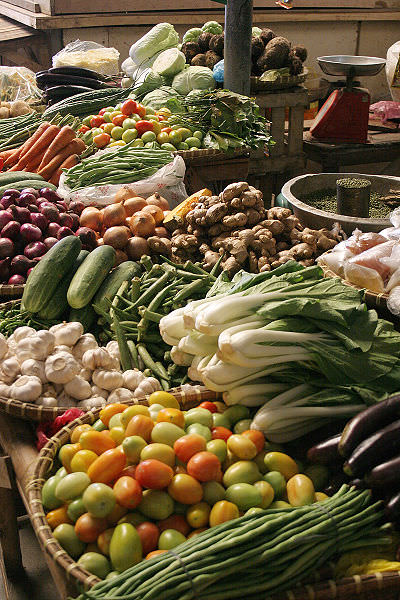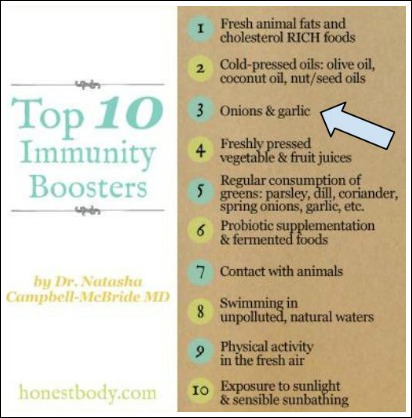Time and again, both in my nutritional training and my own experience with my family, I am shown that the kitchen is the first place to begin for getting well.
Helping our little ones and ourselves get strong and well can come from the most modest and unassuming sources. The two immune boosters that I discuss today could not be more humble and are probably available right now in your pantry.
Garlic. Onions.
Thats it!
Garlic and onions are simple and inexpensive – the best vegetables for highly effective immune boosting if applied in a therapeutic manner.
Garlic and onions are featured as the third of the Top 10 Immune Boosters, taken from the book The Gut and Psychology Syndrome, by Dr. Natasha Campbell-McBride. Simple ways to have robust health.
Why Onions and Garlic are the Best Vegetables for the Immune System
Garlic
While not necessarily awesome for those receiving your kisses, garlic is an absolute champion as a natural antibiotic for boosting the immune system.
- It packs a punch with its phytochemicals and healing sulfur components. These sulfur compounds even chelate toxic heavy metals (like lead & cadmium), binding with them for excretion out of the body.
- Garlic has antibacterial, anti-fungal, and even antiviral qualities
- It promotes the growth of healthy intestinal microflora
- Garlic helps to keep fats from oxidizing. I outlined how this works in previous posts about boosting immunity and cold pressed oils.
- Garlic acts as a strong antioxidant and guards against DNA damage
- It protects against radiation & sunlight damage
- Fights worms and parasites
- It benefits digestion, which is good for the whole body
- It contains many nutrients such as –
Vitamins: C, B1, B2, B3
Minerals: Calcium, folate, iron, magnesium, manganese, phosphorus, potassium, selenium, zinc
Phytochemicals: Allicin, beta-carotene, beta-sitosterol, caffeic acid, chlorogenic acid, diallyl-disulfide, ferulic acid, geraniol, kaempferol, linalool, oleanolic acid, p-coumaric acid, phloroglucinol, phytic acid, quercetin, rutin, s-allyl-cysteine, saponin, sinapic acid, & stigmasterol.
As the book Prescription for Nutritional Healing states, it is “Good for virtually any disease and infection”
Onions
As a whole, the onion family (garlic included) is an immune boosting plant family. Onions in particular help to decrease phlegm and inflammation in the nose and throat, and when applied as a chest poultice they can help with the inflammation and congestion in the chest, such as from a bronchial infection. Onions also inhibit allergic reactions, which are a sign of imbalance in the immune system.
Some of onion minerals worth noting are:
- Manganese
- Potassium
- Phosphorus
- Magnesium
- Calcium
Onions also contain a significant amount of Vitamin C and both onions and garlic (especially red onions) are high in quercetin, the antioxidant which helps inhibit cancer cell growth.
Historical usage
Onions and garlic are featured in historical art, medicine, religious application and culinary tradition. Here are just a few examples:
Pre-antibiotics era, garlic was used to treat infections and wounds during World War I. It is one of the oldest recorded remedies and is listed medicinally in ancient texts of the Greeks, Hebrews, Babylonians, Romans and Egyptians.
Onions were used in the Egyptian mummification process (onions symbolized eternity), as well as in their art. The layered circle form of the onion held special significance.
Apart from growing in the wild, onions have been cultivated for at least 5,000 years, showing up in ancient texts of India, Sumeria, Egypt & China.
Garlic and onion belong to the Allium family of plants, which includes 600 – 750 species. Other popular alliums are shallots, chives, leeks, scallions.
How to use onions & garlic therapeutically
Garlic:
Dr. Natasha recommends consuming a whole head of garlic a day for therapeutic purposes (not just a clove!), and she also outlines its usage as a remedy for ear infection, through garlic infused olive oil.
Garlic for ear infection
Ingredients:
- 1 crushed clove of garlic
- 1 – 2 tablespoons cold pressed olive oil
Method:
Place the crushed garlic in the oil and let sit for 30 minutes, then strain. The oil can be warmed slightly by placing it in a cup and setting the cup in warm water (don’t overheat or this will destroy beneficial properties). Use a few drops of this oil hourly in the ears to treat an ear infection. Garlic oil is a safe remedy for children and can also be used daily (just a couple of drops) to soften ear wax buildup.
The book Healing With Whole Foods outlines more garlic usages:
Garlic tea – Simmer 4 cloves of chopped garlic in one cup of water for 20 minutes…(apply both topically and drink internally) use for relieving poison ivy & poison oak & other boil like skin conditions.
Travel – When traveling or eating out, take 2 capsules of aged garlic or chew up a clove of raw garlic prior, to help avoid food poisoning.
For colds, sore throat, & sinus headaches – Hold a clove of garlic in the mouth for at least 15 minutes, then consume it.
Onions:
Dr. Natasha again gives us simple, time tested remedies.
Onion for ear infection
Ingredients:
- Large white onion
- Cotton cloth
Method:
Chop the onion finely and put it into the cotton cloth. Heat it in an oven until it is hot but still tolerable to touch. Place the wrapped onion on your child’s ear, with a cozy hat over to keep it in place…you can use plastic wrap between the onion and hat to keep the hat from getting onion juice on it. Keep this in place until the onion has cooled and repeat the heating and application on the ear. This is good to do before bed when they can then sleep on the affected ear and keep it very warm. It’s smelly but works well!
For a throat infection
Eggs, onion, & animal fat immune booster (good for any infection)
Ingredients:
- 1 large white onion (sliced)
- 1 – 2 tablespoons animal fat (such as ghee, duck or goose fat)
- 2 – 3 high quality pastured eggs
Method:
- Cook the sliced onion in a pot on low heat, covered with a lid, for about 20 minutes, until onion is soft and sweet
- Fry the eggs in generous amounts of the animal fat until the whites are gently cooked but the yolks are still runny.
- Serve the eggs and onions together with the fat and an extra drizzle of cold pressed olive oil on top
“This dish is very gentle and soothing on the throat, the fat and the egg yolks will dissolve any damaged tissues and help to remove them; the eggs, fat and cooked onion feed the immune system locally in the throat, and boost systemic immunity as well. Give this dish to your child twice a day, and the sore throat will melt away quite quickly. This is food that should be given to patients in hospitals, whose tonsils have just been removed.” – from The Gut and Psychology Syndrome, by Dr. Natasha Campbell-McBride
Storage and preparation
The best way to store garlic and onions is in a cool, dark place with good air circulation. This could be in a paper bag, a mesh basket in the cabinet, or an open box in the pantry. Stored carefully, onions and garlic can keep well for a month or much more. Note: When a clove is taken off a head of garlic, its storage life is decreased.
In preparing garlic, if you cut into the garlic clove and then let it sit for 15 minutes you will be allowing time for the enzymes that turn alliin into allicin.
If you are prepping a bunch of garlic cloves at the same time, you can put the garlic in boiling water for 10 – 20 seconds and then put them into cold water. This should make it so that the skins come away easily.
In preparing onions it is helpful to have a good, sharp knife. Here is a video showing how.
Raw or fermented garlic is preferable for medicinal purposes. There is some degree of potency that is lost during cooking, but some sulphur compounds are actually enhanced during cooking, so there is still benefit.
How we incorporate onions & garlic
- I put onions and garlic into almost every soup I prepare for my family.
- A cheese plate with local artisan cheeses, roasted garlic, dates, fruit & nuts as an at-home date.
- Roasted garlic soup is one of my favorite soups.
- I love making a simple dressing for our salads. It’s made with olive oil, store bought or homemade apple cider vinegar, lots of chopped garlic and a little bit of honey & sea salt.
How do you include these two best vegetables into your daily life? Please scroll down and tell us in the comments below…I’d love to hear about it.
GAPS CLASS
For those of you who are interested in the GAPS Diet for your own family, registration is open for theGAPS CLASS, a class to walk you through the GAPS protocol and help you apply it effectively in your everyday life.
Click here to find out more and receive a free 30 Day Prep Guide for GAPS for signing up for free updates!


No comments:
Post a Comment